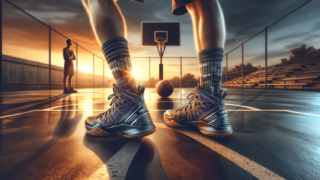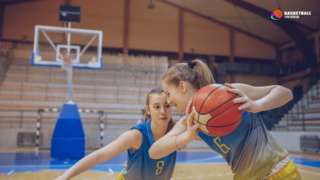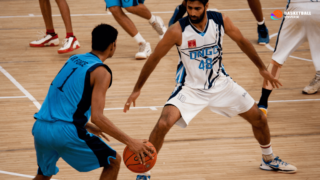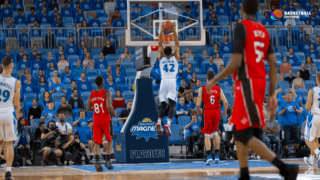How to Lace Basketball Shoes?
Written by: Basketball Universe
Last updated:
For all the thrill-seekers and hoop fanatics out there, we know that having your basketball shoes not only look stylish but also provide the support and comfort needed to perform your best on the court is paramount. But, did you know that lacing your shoes correctly can be a game-changer in both style and performance? Welcome to this comprehensive guide on “How to Lace Basketball Shoes,” where we will dive into the nitty-gritty of lacing techniques, methods, and tips to help you elevate your game to the next level. In this fun and professional space, let’s unlace the mysteries and discover shoe lacing hacks you never knew you needed!
How to Lace Basketball Shoes?
To lace basketball shoes, follow these steps: (1) Start by loosening your laces for a comfortable fit. (2) Insert the laces into the bottom eyelets of the shoe, ensuring equal length on both sides. (3) Choose a lacing technique that suits your needs, such as standard crisscross, over-under, parallel, or loop-back. (4) Begin lacing, and as you go up the eyelets, tighten the laces for optimal support and proper fit. (5) Adjust any excess lace length or tightness to your preferred comfort level. (6) Finally, tie your shoes securely with a double knot or a secure looping technique to prevent them from untying during gameplay.
Preparing Your Shoes for Lacing
Before diving into the exciting world of lacing basketball shoes, it’s essential to create the perfect foundation. In this section, we’ll cover important preparation steps that’ll make your lacing experience enjoyable and efficient.
Clean Your Shoes
Starting with a clean slate is always a good idea. Take a few moments to clean your shoes, ensuring that any dirt or debris is removed from the eyelets. This helps maintain the longevity of your laces and makes the lacing process smooth and seamless.
Inspect Eyelets and Choose Laces
Check the eyelets of your shoes to ensure they’re in good condition. Damaged eyelets can make lacing difficult and may even cause injuries during play. After inspecting your eyelets, choose high-quality, durable laces that are appropriate for your shoes. Consider factors like length, width, and material to ensure your laces are built to withstand the demands of basketball.
Choosing the Ideal Lacing Technique
Now that your shoes are ready, it’s time to explore different lacing techniques, each offering unique benefits and styles. Equip yourself with the knowledge to make an informed decision on which method suits your preferences and performance needs.
Standard Crisscross Lacing
This technique is commonly seen in various athletic shoes and is a time-tested method of lacing basketball shoes. The crisscross pattern provides support, stability, and flexibility during play. To implement this lacing style, simply feed the laces through the bottom eyelets and alternately cross each lace over the other, going up each row of eyelets until you reach the top.
Over-Under Lacing
Over-under lacing reduces friction between the laces, making it suitable for players who experience discomfort due to tight lacing. Begin by threading the laces through the bottom eyelets, but this time alternate between passing the lace over and under the eyelets as you go up. This creates a more comfortable fit while still offering stability and support.
Parallel Lacing
This lacing style offers a clean, minimalist look, perfect for basketball players who appreciate sleek aesthetics. To achieve this technique, pass one lace end directly across to the opposite eyelet, while the other lace end runs up the side before crossing over. Continue this pattern until you reach the top eyelets, and you’ll have a smart-looking shoe with ample support.
Loop-Back Lacing
Loop-back lacing can deliver additional support and a snugger fit, ideal for athletes who require extra security during aggressive games. After threading the bottom eyelets, bring the lace ends up, looping them back into the same eyelet on each side. Next, take both ends and cross them over, passing them through the opposing eyelets. This creates a locked-in feel that keeps your feet stable during intense gameplay.
Mastering Lace Tightening Levels
When it comes to basketball shoes, finding the perfect balance of tightness and comfort is crucial. In this section, we’ll look at various tightening techniques so you can achieve your desired fit.
Gradual Tightening
This method focuses on maintaining comfort while ensuring the shoe remains secure. As you lace up, gently pull on each lace crossing to tighten it just enough to keep your foot in place. Proceed up the shoe, gradually increasing tightness to provide a custom fit. This approach allows the shoe to flex with your foot during gameplay, enhancing comfort and performance.
Zone Tightening
Zone tightening targets specific areas of the shoe, allowing you to tailor the fit to your unique needs. Identify the parts of your foot that require extra support or looser fit, then adjust the tightness of the laces accordingly. For example, tighten the midfoot area for added arch support while leaving the forefoot and ankle areas looser for increased flexibility.
Complete Tightening
Complete tightening cranks up the support across the entire shoe. With this approach, maximize tightness at every lace cross, ensuring a snug fit throughout. This technique works well for athletes who desire a locked-in feel to keep their feet stable during intense basketball activity.
Securing a Reliable Knot
So you’ve laced your basketball shoes to perfection – now it’s time to ensure your work stays put with a secure knot. We’ll introduce different knotting techniques to help you find one that complements your chosen lacing style and keeps your shoes tight during the game.
Standard Double Knot
A tried and true method, the standard double knot provides a simple and effective solution for securing your laces. Tie a standard bow knot, then make a second bow with the loops created. This knot is easily adjusted and provides a secure hold for most basketball activities.
Surgeon’s Knot
This knot delivers extra durability for players who tend to have their laces loosen during gameplay. Begin with a standard bow knot, but before forming the loops, make an additional pass with the lace ends. Once the second pass is made, complete the bow, resulting in a more secure and long-lasting knot.
Loop the Loop Knot
For those looking for a knot that’s both reliable and easy to untie, the loop the loop knot is an ideal choice. Begin by making a loop with both lace ends, then create a small hole between the loops by passing one loop through the other. Once the hole is made, pass the loops back through and pull tightly. This knot provides a secure hold that’s also simple to undo when needed.
Personalizing Your Basketball Shoes
Now that you have the fundamentals down, it’s time to explore ways to add personal flair to your laced basketball shoes. From stylish patterns to functional modifications, these creative ideas will help you stand out on the court.
Colorful Laces
One of the easiest ways to personalize your basketball shoes is by choosing laces in bold or contrasting colors. Whether it’s your favorite hue or the color of your team jersey, incorporating vivid laces adds a touch of individuality and style to your footwear.
Lace Locks
Lace locks not only provide a unique aesthetic, but they also serve a functional purpose by locking your laces in place during intense movement. Available in various designs, colors, and materials, lace locks can dramatically alter the look of your basketball shoes while keeping your laces secure.
Creative Lacing Patterns
Don’t be afraid to experiment with various lacing patterns to achieve a one-of-a-kind look. Explore different combinations of tightening and lacing techniques that suit your desired function and appearance. The possibilities are endless – from diagonal zigzags to lattice patterns.
Conclusion
Lacing your basketball shoes might seem like a simple task, but understanding the nuances and techniques involved can truly elevate your game. By perfecting your lacing style, tightening levels, and knot security, you can optimize performance, comfort, and overall shoe aesthetics. So go ahead, lace up and get ready to dominate the court!
Understanding Different Basketball Shoe Styles
Not all basketball shoes are created equal. There are various styles available, each designed to cater to specific preferences and requirements. In this section, we’ll explore these styles and provide insights into their lacing options and features to help you make an informed decision.
High-Tops
High-top basketball shoes extend over the ankle and provide ample support and stability. They’re popular among players who require added protection for their ankle joints. When lacing high-tops, consider utilizing techniques like loop-back or zone tightening, which offer increased support and adjustability in the ankle region.
Mid-Tops
Mid-top shoes offer a balance between support and flexibility. They cover the ankle but allow for greater movement compared to high-tops. Crisscross or over-under lacing techniques work well with mid-tops, as they promote a secure and comfortable fit while retaining mobility during play.
Low-Tops
Low-top basketball shoes focus on agility and speed, providing minimal ankle coverage but maximum freedom of movement. They’re popular among guards and players who rely on quick footwork. Parallel lacing or gradual tightening can complement the design of low-tops, emphasizing flexibility and responsiveness.
Maintaining Your Laces and Shoes
Investing in proper lace and shoe maintenance can prolong the life of your basketball shoes and ensure consistent performance on the court. Follow these tips to keep your laces – and shoes – in top condition.
Clean Laces Regularly
Dirty laces can deteriorate more quickly and can affect the overall appearance of your shoes. Remove the laces and hand-wash them with mild soap and water. Then, let them air dry before re-lacing your basketball shoes. Also, consider having a spare set of laces available so you can continue playing while your primary pair is being cleaned.
Check for Wear and Tear
Regularly inspect your laces for signs of fraying and weakness, especially at the eyelets and points where they cross. Damaged laces can hinder your game and even pose a safety risk. Replace them as soon as you notice signs of wear to maintain peak performance.
Store Shoes Properly
Proper storage of your basketball shoes can help preserve the shape and integrity of both the shoes and the laces. After playing, loosen the laces to prevent unnecessary stress on the eyelets and give your feet a breather. Store your shoes in a cool, dry place away from direct sunlight to prevent lace fading and material degradation.
Troubleshooting Common Lacing Issues
Encountering problems while lacing your basketball shoes is not uncommon. In this section, we’ll explore some common issues and offer solutions to get you back on track.
Uneven Lace Length
If you find that your lace ends are of different lengths, simply retrace your steps and adjust the laces as needed. Ensure that the laces are evenly distributed at the starting point and that they maintain symmetry throughout the lacing process.
Laces Slipping
If your laces tend to slip or loosen during play, try using a more secure knot, such as the surgeon’s knot, to keep them in place. Alternatively, consider investing in lace locks or performance laces with a grippy texture for added slip-resistance.
Applying Too Much Pressure
Over-tightening your basketball shoes can lead to discomfort and restricted movement. Adjust the lace tension according to your comfort level, focusing on finding the right balance between support and ease. If you find that the issue persists, try experimenting with different lacing techniques to achieve the desired snugness without overdoing it.
FAQ Section
Still have questions about lacing your basketball shoes? Below, you’ll find commonly asked questions and their answers, designed to help you overcome any lacing obstacles and optimize your shoe experience.
1. How do I choose the best laces for my basketball shoes?
Consider factors like length, width, material, and durability when selecting laces. Ensure they are specifically designed for basketball shoes, as these laces undergo more stress and require greater strength and support than regular shoe laces.
2. How long should my basketball shoe laces be?
Lace length varies depending on factors such as shoe size, the number of eyelets, and your preferred tying technique. As a general rule, measure your current laces or consult the shoe manufacturer’s guidelines to determine the appropriate length.
3. Can I use different lacing techniques for each shoe?
Yes, you can use different lacing techniques for each shoe, as long as you’re comfortable and both shoes provide the desired level of support and fit. Some players may have unique requirements for each foot, making it advantageous to use different methods.
4. Should I lace my basketball shoes tightly or loosely?
Finding the right balance between tightness and comfort is key. Aim for a snug fit that ensures stability and security without hindering your foot’s natural movement or causing discomfort. Experiment with different tightening levels to achieve the perfect fit for your needs.
5. How often should I replace my laces?
Replace your laces as soon as you notice signs of wear or fraying. Consistent performance and safety are vital in basketball, and damaged laces can negatively affect both. Regularly inspect your laces and keep a spare pair handy for timely replacements.
6. Can I wash my laces while they’re still in my shoes?
It’s best to remove your laces from your shoes before washing them. This ensures thorough cleaning and prevents possible damage or discoloration of your shoes during the washing process.
7. Do different basketball shoe styles require different lacing techniques?
While lacing techniques can be adapted to various shoe styles, certain methods may better complement the features and benefits of specific shoe types (e.g., loop-back or zone tightening for high-tops). Experiment with different techniques to determine which works best for your shoe style and specific needs.
8. What should I do if my laces keep coming untied during gameplay?
If your laces frequently come untied, consider using a more secure knot, such as the surgeon’s knot. Alternatively, you can invest in lace locks or performance laces that resist slipping and stay securely in place during gameplay.
9. How do I prevent lace bite?
Lace bite results from excessive pressure applied to the top of the foot by tight laces. Prevent lace bite by using a method like zone tightening or over-under lacing, allowing for a more comfortable and supportive fit across the top of the foot.
10. How can I make a fashion statement with my basketball shoe laces?
Get creative with your lacing by experimenting with unique patterns, colorful laces, or adding lace locks to your shoes. This will showcase your personal style and make a fashion statement on the court.
11. Can using two sets of laces provide extra support?
Double lacing your basketball shoes can provide additional support and stability by spreading tension across two sets of laces. This technique can also offer extra security to ensure your shoes remain firmly in place during play.
12. What if my shoes have an odd number of eyelet pairs?
In cases where your shoes have an odd number of eyelet pairs, try utilizing a lacing technique that accounts for this, such as skipping an eyelet or altering the pathway of the laces to accommodate the extra eyelet.
13. Can I make adjustments to the manufacturer’s lacing to improve fit?
Absolutely! Feel free to experiment with different lacing techniques, tightening levels, and knots to achieve the ideal fit and comfort for your feet. Basketball shoe lacing should always cater to your individual needs and preferences.
Featured Posts
- No pillar pages found.





